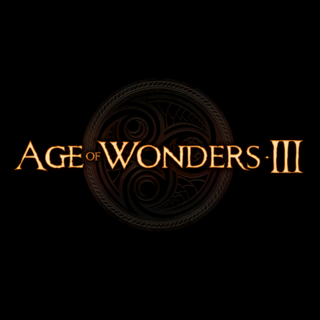FOREWORD:
This review is actually not about the MAC version of the game. Rather, it is a work-around for GameSpot’s inability (or unwillingness) to host two different user reviews from the same user for the same game.
Anyway, this review is for version 1.7 of the game, introduced at the end of the year 2015. Although its gameplay fundamentals remain unchanged, there has been quite a number of significant changes, discounting the DLC.
INTRO:
Age of Wonders 3 has sophistication that is impressively greater than that of its predecessors. However, it is not without its own issues, such as not including content which has been shown in the previous games.
Moreover, although it has solved a lot of balance issues with the previous games, especially with regard to the gameplay system of heroes, it has balance issues in other places, such as the nullification of spells and the seeming superiority in mobility that flying units have over other units.
Since its release, the game has benefited from many updates, most of which do introduce gameplay content in addition to fixing issues and tweaking balances.
Unfortunately, the updates come with a caveat for the customer to worry about, namely a greater need for computing resources.
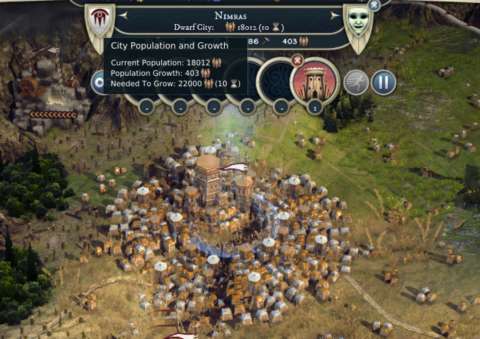
INCREASED MEMORY USAGE BUT IMPROVED LOADING & SAVING TIMES:
The caveats of the updates will have to be gotten out of the way first, if only to emphasize that the updates had not been an idiomatic bed of roses.
The physical memory which the game occupies upon launching was previously less than 1 GB of RAM. Ever since the updates, the amount has inflated to over that. However, this also came together with some noticeable improvements in times for the loading and creation of game-saves, likely because the necessary assets for reloading game-saves have already been pre-loaded into memory. The start-up for the game also seems to be faster.
MORE STABLE GRAPHICS, BUT GREATER POTENTIAL STRESS ON GPU:
In the original version of the game, there were considerable frame rate drops, especially during siege battles. This issue has been addressed by Triumph Studios, who revisited and revised how the game handles its interactions with the graphics processing unit of the computer.
On the other hand, it would appear that these improvements would place the GPU under greater duress. In fact, one of the updates for the game introduces a graphical option which has the game’s programming wait for the GPU to complete its previous task before loading it with more instructions, if only to avoid overheating.
FIRST-PARTY LAUNCHER IS STILL AROUND – BUT MORE USER-FRIENDLY NOW:
The original package of the game riled some customers, especially GOG users, because it requires a rather intrusive first-party launcher. Furthermore, for players who do not want to register accounts in Triumph Studio’s customer base, the original package creates a “guest” account that does not remember any of the player’s custom-selected settings.
This was certainly unacceptable, but fortunately, Triumph Studios has addressed this issue by redesigning the launcher and the guest account. If the player does not already use a Triumph Studios account, the launcher reverts to the guest account by default. The guest account now works like a proper user profile, keeping details such as the player’s chosen graphical and gameplay settings.
This is of course still far from the ideal that is that there should be no first-party launcher at all, but the launcher appears to be irrevocably worked into the game.
GRAVE INDICATORS:
Not all of the additions which have been implemented by the updates are meant for fixes or improvements. Some are to pave the way for DLC packs.
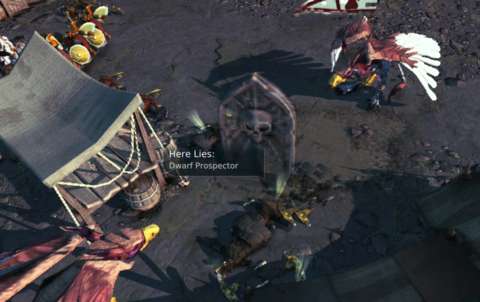
Among these additions are gravestones, which appear where units have died. These will be useful for necromantic magic and certain abilities of the Undead ‘race’, which is introduced in the Eternal Lords expansion.
Without the expansion though, the gravestones’ significance in the gameplay can only be seen in battles which occur in crypts and tombs. If the crypts and tombs have pervasive magic which brings back formerly living units as the undead, the gravestones will be handy in managing the battle, but of little use in other situations.
REBALANCING OF TIER 4 UNITS & ECONOMY:
In the original package, there may have been an issue with Tier 4 units, namely the most expensive units which a race or hero class can field. After the player has achieved the capability to field them, the only reason left not to field them is an economical one. Otherwise, if the player’s economy is considerable enough to support their upkeep, armies of Tier 4 units would likely sweep away any other armies of the same size. Therefore, quite a number of strategies which players developed would involve rushing over to Tier 4 as soon as possible.
This has been partially addressed by tweaking the traits and statistics of a few Tier 4 units. These changes are straight nerfs.
However, the surprise here is that most of the balancing methods were oriented around something other than nerfs. To elaborate, this problem is also addressed by changing the factors which contributed to the economy which supports the fielding of high-tier units. For example, settlements take a lot longer to grow now, and the benefits of certain settlement facilities have also been pared down.
There are also other changes which strongly suggest that Triumph Studios had been looking at the cause of the problem, and not the symptoms.
SETTLER COST CHANGES:
The unit which created new settlements, the Settler, is now a lot more costly to produce. There is an unsurprising increase in its gold price, but the shocker here is that they take much, much more out of the population of the settlement which created them. This was implemented in the V1.1 update.
A later update adds another layer of cost; subsequent settlers after the first one which the player produced are more expensive. There is an eventual ceiling price, of course, for the sake of playstyles which are oriented around creating new settlements; such playstyles will have much higher opportunity costs and risks now, however.
DISJUNCT OVERHAUL, INTEGRITY & REINFORCEMENT:
In the release build of the game, there is an issue of the difficulty of maintaining global spells. Opponents will eventually gather enough power to disjunct any global spell which the player has cast earlier. Re-casting them takes too much time and comes with too many opportunity costs, so there is often little incentive to spend precious casting points on global spells instead of spending them on combat spells.
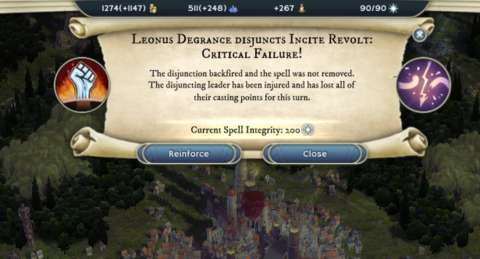
The V1.4 update has addressed this issue by revamping the mechanism of Disjunction and introducing the element of Spell Integrity and the Reinforcement feature.
The key detail in the revamp of Disjunction is that it no longer has to be researched; it is always available by default. The rest of the revamp may not please everyone though; Triumph Studios has introduced RNG rolls into the mechanism. There is the percentage of regular success for the disjunction of a spell. There is also a percentage for a smashing success, in which the spell is removed and the leader who cast that spell is injured too, and also lose all of his/her casting points. There is also a percentage for a critical failure, in which the leader who is attempting the disjunction is the one who is harmed instead.
Fortunately, this is not an all or nothing matter. Even upon a failure at disjunction, the targeted spell is weakened. This is made possible through the implementation of the “Integrity” mechanism.
Global spells and battlefield-wide combat spells now have their own strength counters, called “integrity” in-game. This is a factor in the RNG rolls that a disjunction attempt would make; spells with high integrity are next to impossible to neutralize with just one disjunction attempt, and they also happen to increase the chance for a critical failure.
On the other hand, a failed disjunction attempt happens to weaken the integrity of the targeted spell, making it easier to remove on a subsequent disjunction attempt.
For the case of global spells, the leader who cast them can increase their integrity by spending casting points and mana. This is a useful way to spend surplus mana and make sure that leftover casting points are not wasted.
To counter strategies which involve significant reinforcement of global spells, there is the research option of “Greater Disjunction”. This allows the player to spend twice the number of casting points and mana for a much better chance of success.
Battlefield-wide combat spells cannot be reinforced, so they are doomed to being neutralized if the opposition is intent on breaking them down.
MANA RESOURCE REVAMP & TWEAKING OF GLOBAL SPELL COSTS:
In the release build of the game, there was a rather pervasive issue of players having more mana than they could ever want.
This issue has been addressed by a considerable overhaul of the mana resource. Some of the changes might not seem to be good fixes though.
Chief of the least convincingly good change is a cap on a player’s mana reserves. If the player’s incoming mana income brings the reserves over the cap, any excess mana is wasted.
Of course, wasting excess mana is not an issue if there is nothing worthwhile to spend mana on. This is where the tweaking of global spell costs come in.

The casting cost of global spells have been greatly reduced, making them much easier to re-cast if they are neutralized. However, their upkeep requirements have been considerably increased, so their usage comes with long-term opportunity costs.
As for the cap on mana reserves, the cap can be raised by either improving the leader’s spell-casting ability, or building facilities which raise the cap. These facilities actually have been in the game since release, such as the Great Temple, but they have the cap-raising benefit added onto them.
GENERAL REBALANCING OF UNITS:
In addition to tweaks to the economy in order to reduce the tendency to rush to Tier 4 units, there have been considerable rebalancing of many units, both to nerf them and to buff them.
As an example of a nerf, there is the Rogue leader’s Tier 2 unit, the Assassin; previously, it had the ability to simply pass through walls and cover, making them incredibly powerful flankers. This ability of theirs have been removed and replaced with Wall-Climbing and Sprint instead. (In version 1.2 of the game, the Assassins do regain the ability to pass through cover, but only as an Elite-rank ability.)
As an example of a buff, many machine-type units now have the Ram ability. They are still incapable of retaliating in melee combat, but being able to Ram considerably improves their close combat performance.
Some changes can be categorized according to themes though; these will be described shortly.
CHANGES TO RACIAL UNITS FIELDED BY LEADERS:
There were some grumblings about how there were not enough differences between the leader-class-affiliated unit of one race and the leader-class-affiliated unit of another race, e.g., in the case of the Rogue leader, the Elven Bard is not that much different from the Dwarven Bard.
Furthermore, where there are differences, they were obvious advantages to the unit which has these differences. For example, the Elven Hunter (which an Archdruid leader can field) and Elven Mounted Archer (which a Warlord leader can field) are straight upgrades over their counterparts of other races.
This was addressed in version 1.2 of the game, far more than version 1.1 did. Many of these changes are straight buffs, apparently in an attempt to differentiate the units of the same leader-class but of different races.
For example, the human Hunter, human Scoundrel and human Engineer can now throw nets – something that the Hunters, Scoundrels and Engineers of other races cannot do.
However, gameplay balance may have been affected as a consequence. For example, the Evangelist of any race previously did not have any ranged attacks; the Draconian one now has Fire Bolts. The Draconian Evangelist does cost more to field, but its increased versatility in battle is worth far more than the increased cost.
BUFFS FOR LOW-TIER UNITS:
In version 1.2, low-tier units have their hitpoints buffed across the board, making them a tad more survivable, especially late-game. There were little other notable buffs, unfortunately.
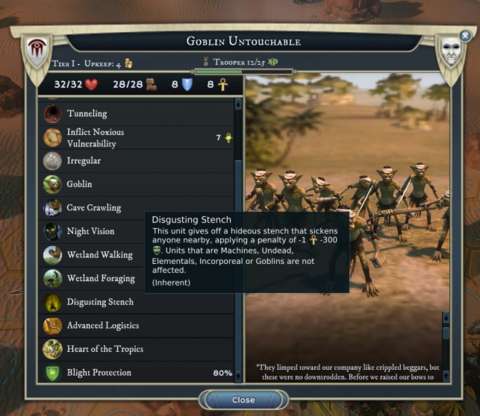
However, in version 1.4, there were more significant changes. Many of these are for the Irregulars of each race, i.e. the unit which can be fielded by any settlement regardless of its state of development.
For example, the Goblin Untouchable now has Disgusting Stench, which causes almost any other unit in an adjacent tile to suffer considerably reduced morale. This means that any would-be melee attackers have to risk a bad morale roll, thus fumbling their attacks.
An even more bizarre and entertaining improvement is the Stone Breaker trait for the Pioneer, who is the Dwarves’ irregular unit. This turns the Pioneer into a hard-counter against Earth Elementals, Stone Giants and any unit which has been buffed with Stone-skin. Learning this the hard way, i.e. being on the receiving end of the Pioneer’s picks and thrown stones, can be an unpleasant surprise.
There are also improvements for other low-tier units, especially the “regimented” soldiers such as the pikemen and swordsmen of the various races. A notable example is that all polearm infantry units have been given the “Pike Square” trait, which grants them protection against attacks from cavalry and fliers. This is a much needed buff, because there are high-tier cavalry that could previously make red ruin of even supposedly anti-cavalry units, such as the Gryphon and Manticore Riders and the human Knights.
NO MORE DE-BUFF STACKING:
In the initial build of the game, de-buffs could be stacked onto a victim. In the case of de-buffs which inflict vulnerability to specific damage types, this stacking can be severe. This is no longer the case; only one instance of any type of de-buff can be applied on a unit.
Moreover, an already inflicted de-buff cannot be “refreshed” via the application of the same de-buff again. The next de-buff can only be applied after the previous one has been removed.
MOUNTAIN-TRAVELLING CHANGES:
In the initial build of the game, mountains are practically effective barriers to any land unit, including even land units which have mountaineering. Rather, flying and floating units are the ones who can travel through mountains with impunity.
This is no longer the case. Flying and floating units now spend 5 movement points for each mountain tile, whereas units with the Mountaineering skill spend up to 6 movement points – just enough to compete with the former.
CHANGES TO TUNNELING:
Previously, tunneling through the subterranean layer did not do much other than to connect two sections of the underground together. Now, every dirt tile that is cleared grants a bit of gold to the player. For the Goblins and Dwarves, this would be an incredibly good start for them because they can tunnel through the underground to gain funds for the early-game period.
Another notable change is that Stone Giants can tunnel now too. This can make for a very unpleasant surprise for their enemies.
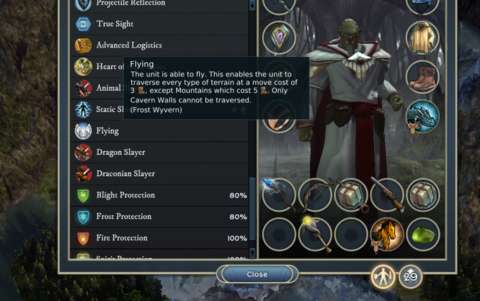
ATTACKS OF OPPORTUNITY COUNT AS FLANKING ATTACKS:
Attacks of opportunity are attacks which are inflicted by any adjacent enemy on a unit that is trying to disengage from melee, or has to pass by said enemy when attempting to go somewhere. However, they do as much damage as regular attacks (if the attack is not inflicted against the rear arcs of the unit), meaning that a player can still risk having units absorb the attacks if getting them to where they are needed is advantageous.
This is not the case anymore, because attacks of opportunity count as flanking attacks, regardless of the units’ facings. This means that strategic positioning of units is now more important than it was.
CHANGES TO EMBARKED UNITS:
In the release build of the game, embarked units actually become more powerful, because they gain the ability to fire ballistae and cannons from their ships. This is no longer the case by version 1.2.
In return, embarking no longer reduces the damage output and the hitpoints of the embarked units. Instead, they suffer reduced defense and resistance, which means that they are now much more vulnerable to enemies which are better suited for naval combat and those which are already floating or flying in the first place.
The movement capabilities of embarked units have also been altered. They have reduced movement points, but benefit from a change to the movement cost across water tiles.
REDUCED MOVEMENT COST FOR WATER-BORNE UNITS:
Previously, water-borne units, such as naval ships, consume 4 movement points for each tile crossed. This has been reduced to 3. This means that naval ships can now respond to incursions across water a lot quicker; after all, they can move further than any embarked unit. Consequently, the value of naval ships has increased considerably, if the map is composed of a lot of water.
EXPERIENCE SYSTEM CHANGES:
Previously, units which only attack once per turn, such as siege engines and archers with crossbows, cannot match the experience gain rate of units which can potentially attack multiple times in a single attack order. Furthermore, certain abilities which inflict no damage, such as de-buffs do not grant a lot of experience points when used. Getting damaged did not grant experience either.
These have changed. Single-hit attacks now grant twice as much experience as they did, casting buffs and de-buffs grant experience and getting struck in melee combat also grants experience. In the case of the experience granted by getting hit in melee, the amount of experience points gained is proportional to the difference between the tier of the attacker and the tier of the defender. This means that if a low-tier unit can survive an onslaught by a high-tier unit, they are likely to be promoted.
Speaking of promotions, units can only gain one rank per battle, where earlier, there was no cap on experience gains. This is perhaps the greatest change in the experience system, because it greatly diminishes min-maxing exploitation.
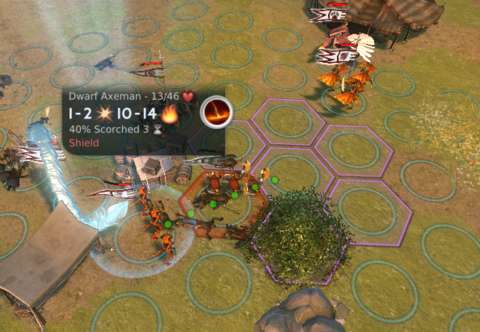
CHAMPION RANK:
Heroes may have level caps, and non-hero units used to have them too. The latter is no longer the case. After the version 1.4 update, elite-rank units can continue to accrue experience points, with the next rank requiring almost the same amount of experience to reach elite rank. Any rank above “elite” is called “champion” ranks in-game.
However, instead of new abilities or statistical increases across the board, champion units only gain hitpoints upon reaching the next rank. Nevertheless, this makes units more durable, particularly if they are low-tier units.
REBALANCING OF TRAITS & NEW TRAITS:
Certain abilities have been rebalanced in order to make them less exploitable. For example, many powerful magical abilities, such as the Throw Curse debuff, have cooldowns where previously they did not.
In addition to the implementation of cooldowns, the nerfs also include higher movement point costs for certain abilities. For example, previously, the Trebuchet could move at any distance and still launch a boulder. Now, it can only move one tile before it has to spend the rest of its movement points to hurl a boulder.
Weaker abilities have been buffed instead. For example, Fire Bombs no longer have any damage fall-off.
There are also new traits introduced in the updates. A prominent example of these is Killing Momentum, which grants a unit more movement points if it manages to score a kill within its turn.
DE-BUFFS WHICH DISABLE RETALIATION:
There are now additional de-buffs which prevent retaliation, such as Dazzled and Slow. These are practically variants of the Panicked de-buff. Unlike the Panicked de-buff, these allow the owning player to maintain control over the affected units, though the player will have to be careful about their positioning after they have been afflicted with these de-buffs.
CRITICAL HIT AND FUMBLE REBALANCE:
In the initial build of the game, the damage output of critical hits fluctuated immensely, whereas fumbles (i.e. critical “misses”) were occasionally so weak that the attack is wasted.
There is now a maximum cap on the bonus damage that critical hits inflict, whereas fumbles have a minimum damage output based on the percentage of the fumbling unit’s average damage. These changes go a long way to reduce the significance of the factor of luck in this gameplay element (which in the eyes of this reviewer, is good).
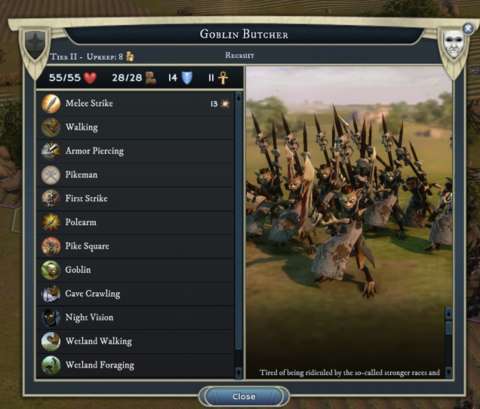
LOADING SCREEN REMINDERS:
The loading screens have been updated to include helpful tips. For example, there are tips which mention that the magic which permeates magic-infused places like mana nodes can be neutralized with disjunction.
RESURGENCE FOR HEROES:
In the original package of the game, losing a hero whose survival is a mission objective in a campaign scenario would immediately lead to a game-over. This was a bit frustrating, especially considering that heroes are the player’s most powerful units and there could be much to be gained from risking their lives.
To address this issue, the difficulty settings below “Hard” have been altered so as to provide every Hero in the player’s employ with the “Resurgence” trait. As a reminder, this is a trait which allows a unit which has been killed during a battle to come back with over a third of its hitpoints if its side won the battle.
Furthermore, the Resurgence trait is now available to every hero by default in non-campaign sessions. This means that players can take more risks with their heroes, if they are sure that they can win a battle by doing so.
ORIGINAL CAMPAIGN TWEAKS – HERO LEVEL CAP FOR EACH SCENARIO:
In the official campaigns of Age of Wonders 3, namely the stories of Edward Portsmith and Sundren of House Inioch, there is a level cap of 20 for heroes. This is implemented from the get-go, meaning that the player can have heroes reaching level 20 even before the finale of the campaigns. This can cause gameplay pacing issues, e.g. the player starts the next scenario with heroes which can overpower any enemy in the player’s starting region.
This has been fixed by implementing a level cap for each scenario. For example, the last scenario in a campaign would have a level cap of 20, but the penultimate one would have a cap of 16.
CUSTOM GAME OPTION FOR LEVEL 30 HEROES:
There is an option for non-campaign scenarios which raises the level cap for Heroes from 20 to 30. This allows the Heroes to take just about every advancement option that is not a statistical increase, meaning that they can become so versatile to the point of being overpowered.
INCREASING THREAT FROM MARAUDER-SPAWNING LOCATIONS:
In the initial build of the game, there were locations such as monster dens, bandit camps and boneyards which spawn groups of units which are hostile to any player; these are indicated by silver banners with red trims on the world map. For ease of reference, these will be referred to as “marauder mobs”.
Previously, these locations would create groups according to the parameters which have been set for the scenario, meaning that they either spawn groups that would be too weak to fight experienced low-tier units or high-tier units as the session moves forward, or they spawn groups of rather powerful enemies that can be too much for early-game armies to oppose.

In version 1.4 of the game, this has been addressed through the implementation of a broader mix of units which are associated with a type of marauder-spawning location, as well as scripts which determine which units are spawned as the session progresses. To elaborate, marauder-spawning locations now produce mobs with low-tier units at the start of any scenario, but if they are left untouched, they begin to spawn higher-tier units.
However, the units which are already guarding these locations still do not appear to change throughout a session. This means that they still become easier to sweep away as time passes, assuming that the player could get through the mobs which are patrolling the vicinity of these locations.
IMPROVEMENTS FOR COMPUTER-CONTROLLED OPPONENT:
In the initial version of the game, CPU-controlled players tend to be careless or even clueless. Despite having perfect knowledge of the map, they are often ill-prepared for flanking attacks across the global map. They also used to trespass willy-nilly, thus building up ill-will with independent settlements and thus preventing them from including such settlements in their expansion strategies.
Both flaws have been addressed. In non-campaign scenarios, CPU-controlled players will use their perfect knowledge of the map to ensure that they can cover any approach to their domain with some sentries. For example, if there are considerable bodies of water on the borders of their territory, they are likely to raise a navy. They will also attempt to at least obtain Open Borders agreements with independent settlements.
CPU-controlled players also had a tendency to “turtle”, i.e. they stay in their cities and build up a considerable defense force – often composed of only a few types of units, i.e. quantity over quality.
They still do this, but they will now sally forth if they noticed that their enemies have made the mistake of not keeping their armies adjacent to each other.
The best improvements are seen during actual battle. Computer-controlled players are now much more mindful of the capabilities of the units at their disposal, e.g. they will avoid having cavalry attack pikemen, even if the pikemen are the only enemies remaining. They also no longer expose units to attacks of opportunity, unless they really want an enemy unit dead (especially if it is a hero).
Overall, to quote the patch notes, the CPU-controlled player now “kicks more buttock” – at least on non-campaign maps.
PROBLEMS WITH CPU-CONTROLLED PLAYERS IN CAMPAIGN MAPS:
Unfortunately, the improvements in the decision-making capability of CPU-controlled players do not extend to those in the campaign maps. They only benefit from the revised decision-making scripts during battle, but on the global map, they are still abysmally stupid.
This is especially the case for CPU-controlled players with a particular role to play in the story, other than just being another opponent for the player. If they are scripted to do particular things on a map, many of the revised scripts just do not seem to apply to them.
This can be seen in the final map in Sundren’s campaign, if she decided to stay loyal to the Elven Court. Her Elven Court allies are practically paralyzed, unable to help the player in the advance towards the enemy’s capital. They cannot help the player hold territory either. In fact, their scripts just seem broken.
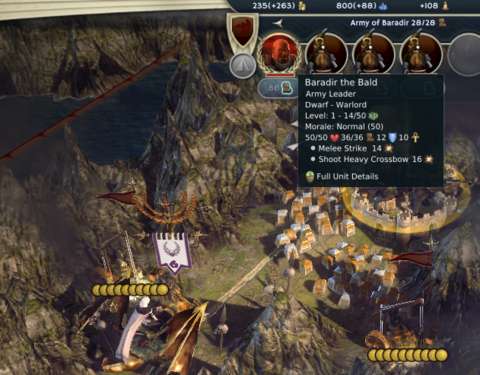
SURRENDER REVAMP:
In a non-campaign match, a CPU-controlled player may realize that it has been beaten after having its military decimated and unable to check an opponent’s advance. In this case, the CPU-controlled player will surrender to the conqueror, turning over its Throne City to the victor. More importantly, the surrendering player’s leader-hero will be converted into a regular hero for the victor, further adding to the victor’s strength.
IMPROVEMENTS TO DIPLOMACY MECHANISM:
Previously, having an Open Borders agreement with another player or independent city only allows the player to move armies through tiles which are not occupied or which do not have structures. With the version 1.4 update, players who have Open Borders agreements with each other can now move units on each others’ structures without impeding their productivity.
This also means that allies may occupy structures in order to defend them. For example, a player could have a fort at one end of a bridge but no units to utilize it. An ally can station units at the fort and make use of it in the owning player’s stead.
Few players abide trespassers. With that said, trespassing armies can now be attacked by anyone whose territory is being intruded upon; a declaration of war is no longer. Of course, it will wreck relations between the conflicting parties further than the trespass already does.
The improvements are not limited to just gameplay designs. There are also animations for the leaders when diplomatic developments occur; there are not unlike those seen in Civilization IV.
HAPPINESS/MORALE SYSTEM CHANGES:
In the original build of the game, the player could go on a roll of victories in battles, thus accumulating considerable bonuses to the happiness of the people of his/her empire and the armies who participated in those battles. Thus, the player could reap the ever-increasing rewards from the improving happiness. Alternatively, a string of losses can doom a player to a negative feedback loop.
For better or worse, Triumph Studios’ solution to this source of gameplay imbalance is to remove these bonuses and penalties, at least for the matter of empire happiness. Units can still feel demoralized or elated after losing or winning a battle respectively, but the changes to their morale will not stack for every subsequent battle, unless it is a different outcome (in which case the morale bonus or penalty is cancelled out, whichever applicable).
Interestingly, many de-buffs will now inflict morale penalties as well. For example, the Immolated de-buff, which previously applied only fire damage over time, now inflict a severe morale de-buff. This is perhaps understandable, as being set on fire is very unpleasant.
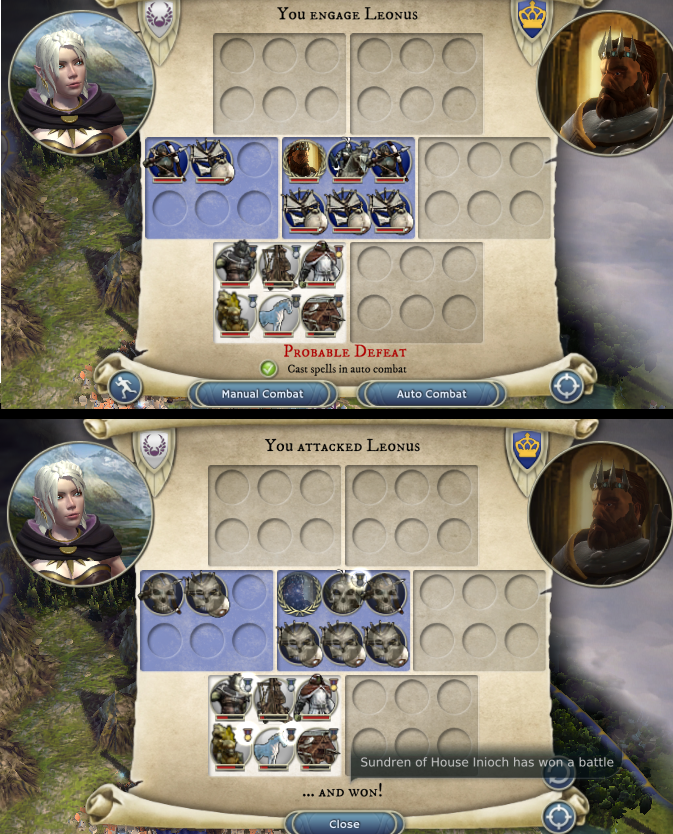
REPAIRING MACHINES:
Previously, Machine units are not worth the trouble of fielding of them, despite being quite powerful. This is mainly because they are difficult to maintain, since only Dreadnought heroes and their repair abilities are the most readily available means of restoring their hitpoints. The other methods require some investment, such as nurturing Engineers to Expert rank and building Master’s Guilds in cities – investment which comes with considerable opportunity costs.
Updates version 1.4 & 1.5 addressed this issue. Interestingly, the solution is not the granting of the Repair Machine ability to more units. Rather, the solution is the implementation of the new Maintenance trait to existing units like the Engineer and the Builder. This trait does not allow them to restore the hitpoints of Machine units during combat, but does so over a turn on the global map.
The Master’s Guild is now a more lucrative structure, because it can now grant the Repair Machine ability to any Builder which is created in the same settlement. Speaking of the Repair Machine ability, it does not appear to have any cooldown at all, unlike other hitpoint-restoring abilities. This may be an overlooked mistake.
REBALANCING OF LEADER-CLASS SPELLS:
The element-based spells were mostly well-balanced right from the release of the game – likely because Triumph Studios already has two games before Age of Wonders 3 to fine-tune them. However, the third entry introduces new sets of “spells” which are unique to the leader classes, and unfortunately, not all of them are well-balanced.
For example, the Warlord leader has a spell, “Authority of the Sword”, which extends the domain of a city. Considering the incredible usefulness of this spell, it had a rather low maintenance cost. As another example, albeit a converse one, the Sorcerer leader’s Arcane Binding spell had an RNG roll for success which makes it not cost-effective, considering how much mana it needs.
The updates have addressed these imbalances. Returning to the example of the Authority of the Sword, its maintenance cost has been doubled. As for the example of the Sorcerer’s Arcane Binding, it guarantees a success, thus making the Sorcerer a hard-counter for other Sorcerers.
RACE HAPPINESS:
Version 1.5 introduces a gameplay element which adds further complexity to the matter of keeping the population in the player’s empire happy. To be specific, each race now has an approval rating of the player. This rating mainly depends on how the player has been treating that race.
Unfortunately, in the vanilla version of the game, these approval ratings merely act as happiness modifiers for settlements which are populated by specific races. The additional layer of complexity that is “Racial Governance” appears to be only enabled with the Eternal Lords expansion.
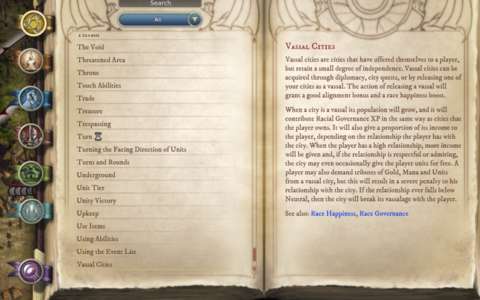
VASSALS:
The vassalage system is introduced in version 1.5, primarily as a way to get independent settlements under the (supposedly) benevolent player’s dominion a lot quicker.
When a player has curried enough favour with an independent settlement, it will eventually offer to become a vassal of the player – usually after having another quest fulfilled. Alternatively, the player can dole out some gold to quicken the process.
Once an independent settlement becomes a vassal, its sight range is added to the player’s own; it retains its standing armies and will continue to grow and build facilities. Once in a while, it will voluntarily offer tribute to the player, which can either be a clutch of resources or a small army. Either tribute can be advantageous when taken at an opportunistic moment.
Alternatively, the player could demand tribute when the ‘cooldown’ for diplomatic deals with vassals has run its course. However, this will hurt the player’s relations with a vassal; resorting to this too much will eventually cause the vassal to cease its servitude.
If the player is careful with his/her treatment of vassals, the vassals will eventually offer to join the player’s empire. This removes all of their standing armies, but the settlement will be obtained intact and will retain any facilities which it has already built.
Interestingly, the player can also grant vassalage to a settlement which is already in the empire’s fold. This improves the player’s relation with the race of that settlement, at the obvious cost of losing that settlement and its immediate contribution to the empire.
SELLING HERO ITEMS:
Previously, the player is given two choices upon finding an item which a Hero can equip from having cleared a treasure site: he/she can either sell it or keep it. In the case of the latter, there is no way to get rid of an unwanted item, other than to destroy them outright without any compensation for the loss.
In the version 1.5 update, hero items can now be sold after the player has chosen to keep them. However, the value of the sale is noticeably lower than that for selling the items when the player first found them.
Furthermore, there are a few noticeable exceptions to this feature. For example, eggs which have been created from a certain spell (“Summon Mount”) will produce mounts which cannot be sold. This is an understandable limitation, because the aforementioned spell might have become too useful otherwise.
EXPANDED ITEM FORGE:
As a reminder, the Item Forge is a feature in non-campaign maps which allows players to build items for their heroes to use, albeit at significant costs. There are now additional item abilities which have been added to the repertoire; these, of course, come with considerable costs, as to be expected.
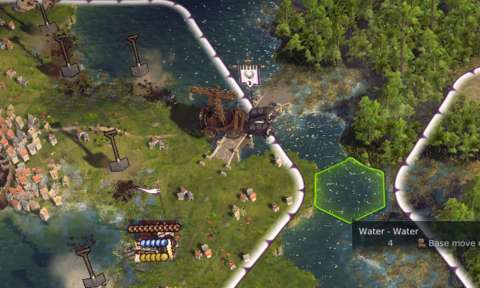
UPDATED TUTORIAL:
Considering the significant amount of improvements and other changes to the gameplay, the original tutorial eventually became outdated and inadequate. Fortunately, in the version 1.6 update, the tutorial was updated to reflect the changes. This might have come rather late, but there are few game-makers who do re-visit the tutorials for their games and address the gaps in the lessons which are imparted.
MODDING TOOLS:
Although there was a scenario editor for the game before the version 1.7 update, there were no tools to completely overhaul the game. With that update, the tools are now there, for ardent players who believe that they can do better with the designs of Age of Wonders 3 than Triumph Studios.
On the other hand, the introduction of official modding tools where there were none previously usually signals the end of official support for a game. Indeed, with Triumph Studios making remarks about its upcoming new game at this time of writing, this might soon be the case.
BUG PATCHES, DOCUMENTATION FIXES & INTERFACE CLEAN-UP
The original package of the game has a considerable number of bugs, especially with its user interfaces.
For example, previously, sending items to heroes was a tad tedious, because the process requires the player to start from clicking on the button to look at the list of hero items on the ground, instead of from when the list is already available from viewing. This has been fixed.
Another example is the fixing of descriptions for some abilities, especially after the abilities have been rebalanced but the documentation has not been updated. Granted, this statement is not done in praise of the game-makers; this should not have happened if Triumph Studios had been thorough. Nevertheless, it is better to be late than never.
CONCLUSION:
There are plenty more changes which are not mentioned in this article, for the sake of brevity. Many of these are for the betterment of the game, and also happens to be the culmination of Triumph Studios’ response to feedback from players. Many of them also happen to contribute to new strategies, especially the introduction of additional abilities to existing units.
For players who have purchased the game’s license and played it from day one, such updates would seem to be good value for their money and time. The only wrinkles to be had are that the game has increased memory usage over its original build and options which improve its performance at the cost of greater strain on the player’s GPU.
